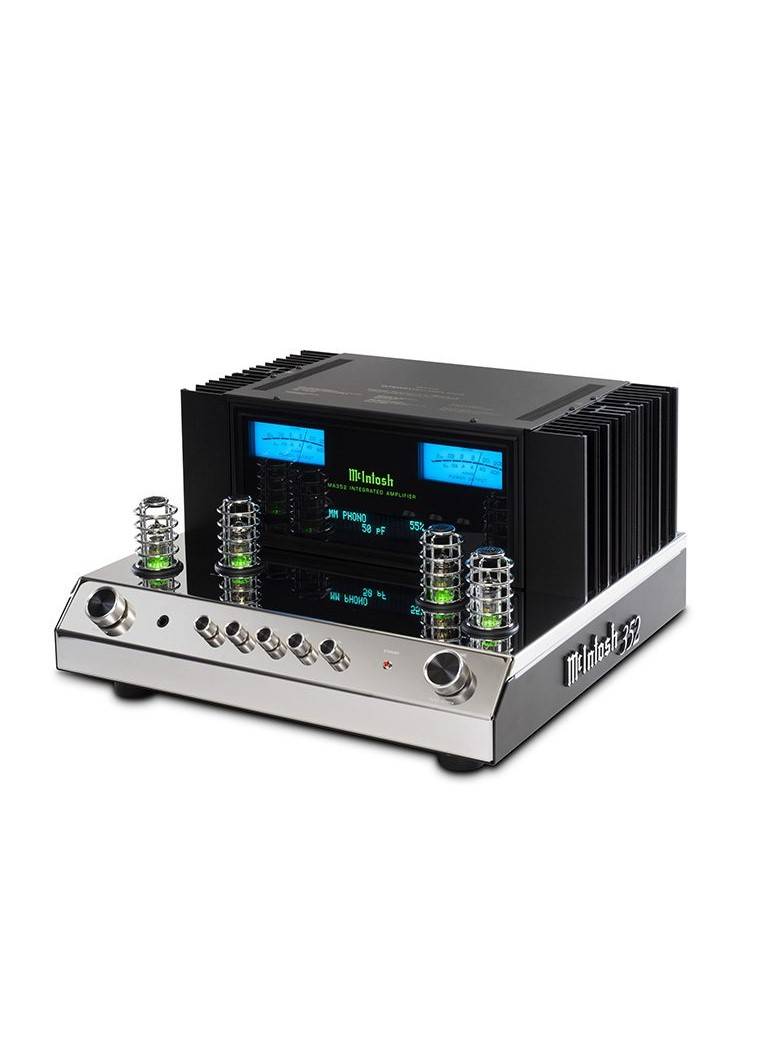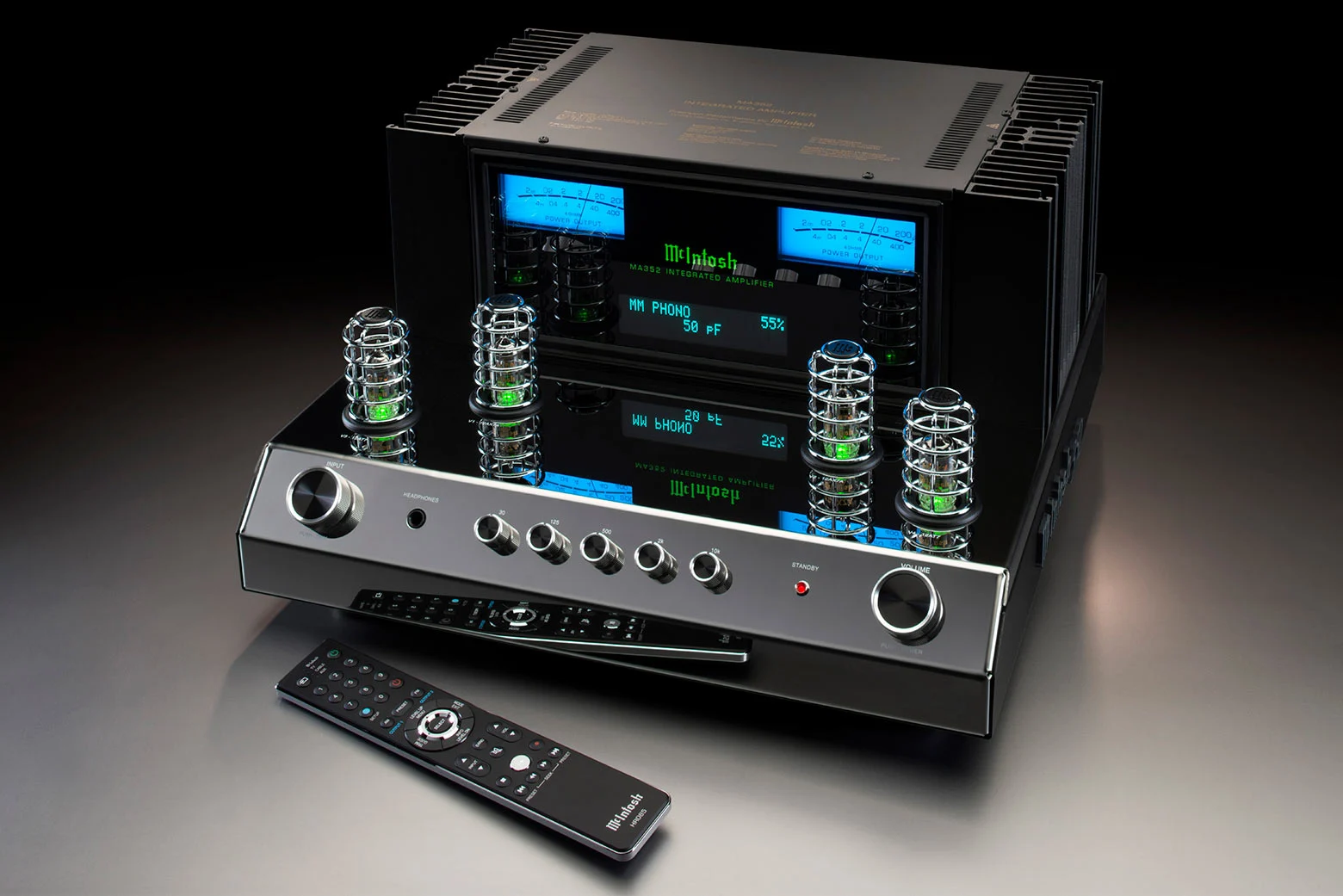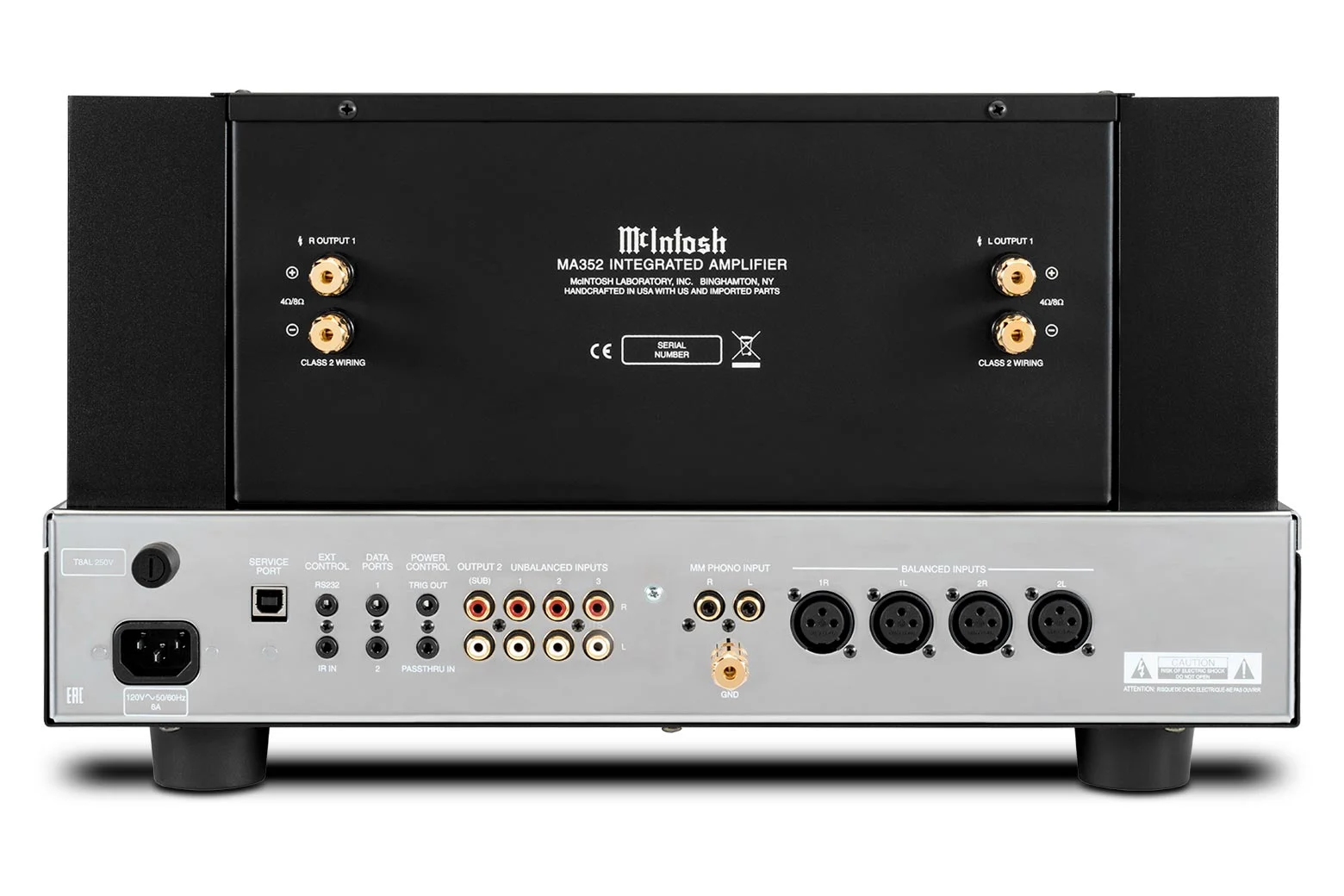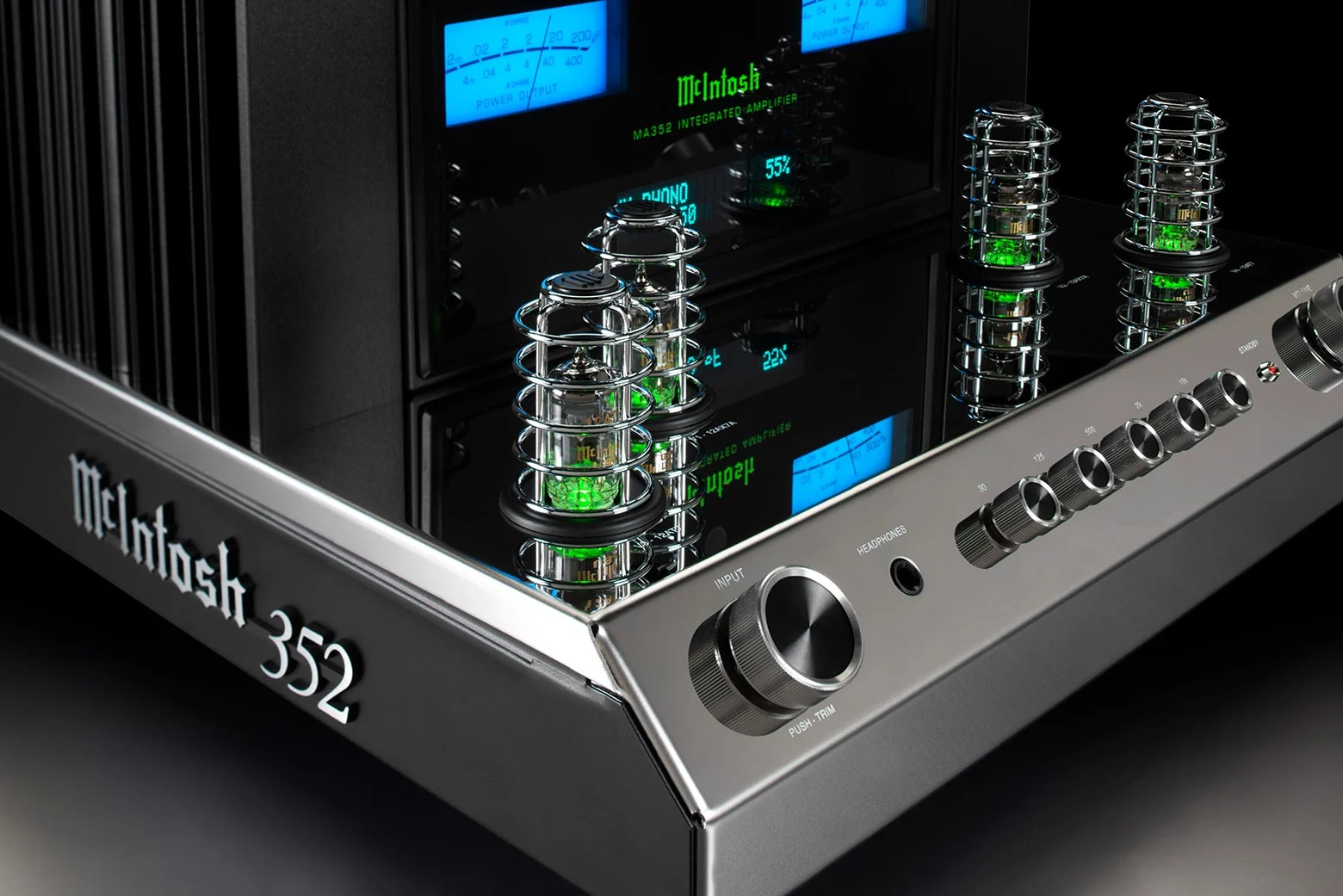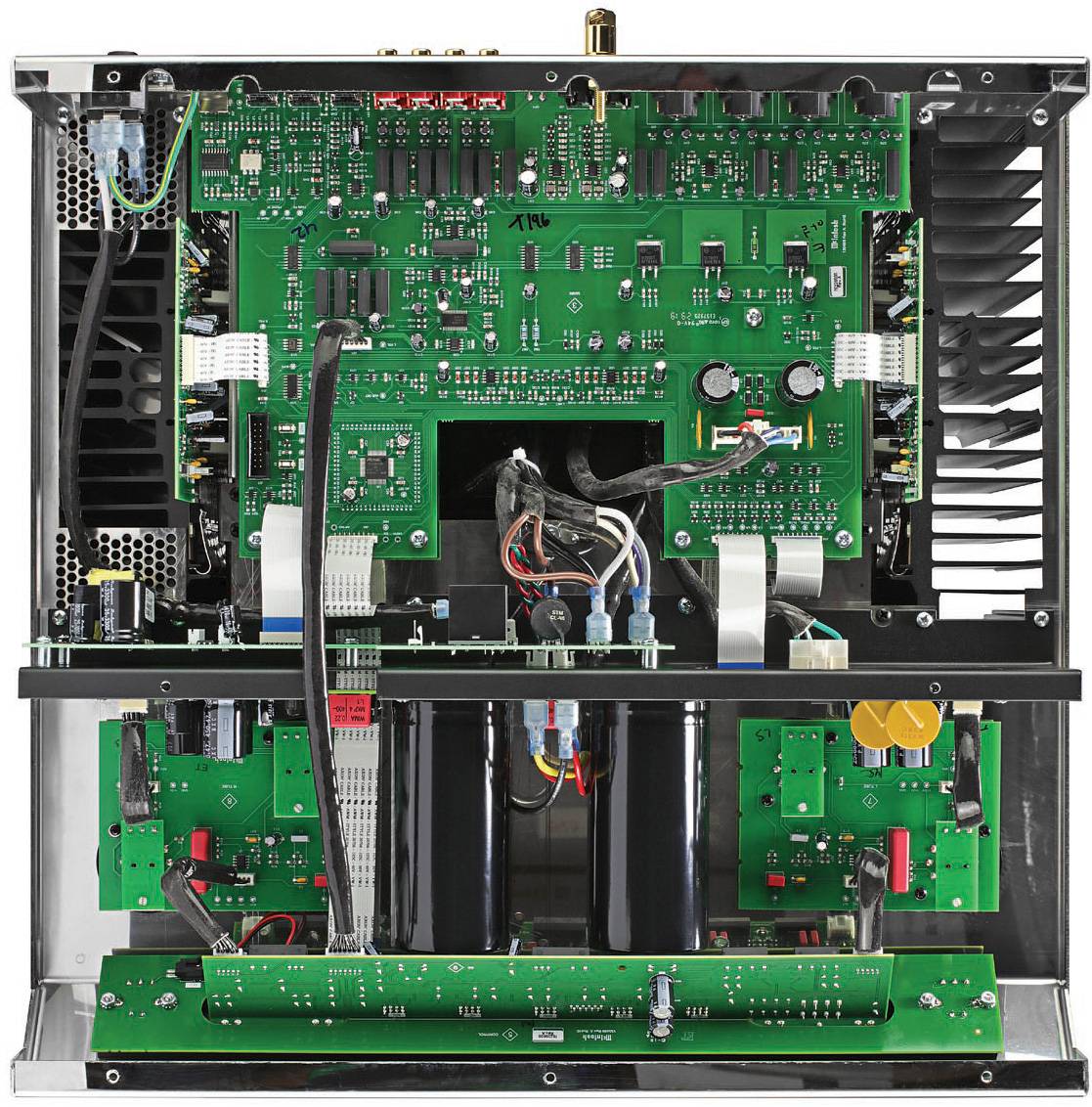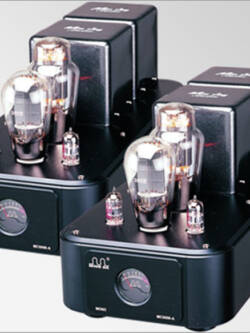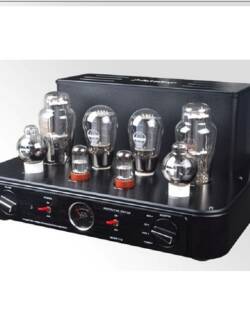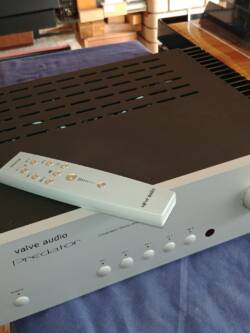McIntosh MA352 2-Channel Hybrid Integrated Amplifier
Original price was: R178,000.00.R85,000.00Current price is: R85,000.00.
Technical specifications
- Type: Hybrid valve/solid-state integrated amplifier
- Power output: 200 watts into 8 ohms, 320 watts into 4 ohms
- Valve complement: 2 x 12AX7A, 2 x 12AT7
- Inputs: 4 x unbalanced RCA line level, 1 x RCA phono (MM), 2 x balanced XLR line level
- Frequency response: 10Hz-100kHz +0/-3dB
- Total harmonic distortion: 0.03% from 250mW to rated power
- Signal-to-noise ratio Line: 93dB below rated output. Phono: 82dB below 5mV input
- Input impedance: Line level 20k ohms, phono 47k ohms
- Headphone impedance: 100 to 600 ohms
- Dimensions (HxWxD): 251mm x 445mm x 521mm
- Weight: 29.9kg
- Price: £8,995, $7,000
Description
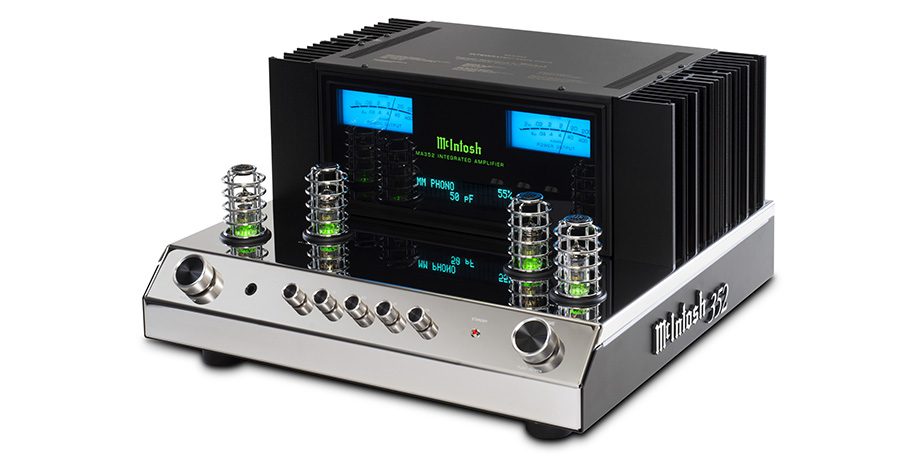
Many are fascinated by the sonic charms of valve amplifiers, and I am among them. However, a single-ended valve amp pushing out 10 watts may not be up to the task of driving inefficient or ‘difficult’ loudspeakers—and certainly not at high levels in a large room. Enter the McIntosh Labs MA352, one of a growing breed of hybrid amplifiers.
These amps attempt to offer the best of both worlds, often combining a valve preamplifier stage with a transistor power amp.
US company McIntosh has an impeccable pedigree, introducing its 50W-1 valve power amplifier in 1949. That was the year Frank McIntosh and Gordon Gow founded the company in Silver Springs, Maryland. It moved to its current factory in Binghamton, NY, in 1951. The company’s current CEO, Charlie Randall, has been with McIntosh Labs for the longest time. He is one of those super-energised, super-enthusiastic people who keep driving what could be a very brand ever forward.
Huge range
McIntosh manufactures a wide range of products, from phono stages and headphone amps to turntables and DACs. However, it is best known for its amplifiers. The company makes all its amplifiers in-house, from the sheet metalwork for the cases to flow soldering the circuit boards and winding its transformers.
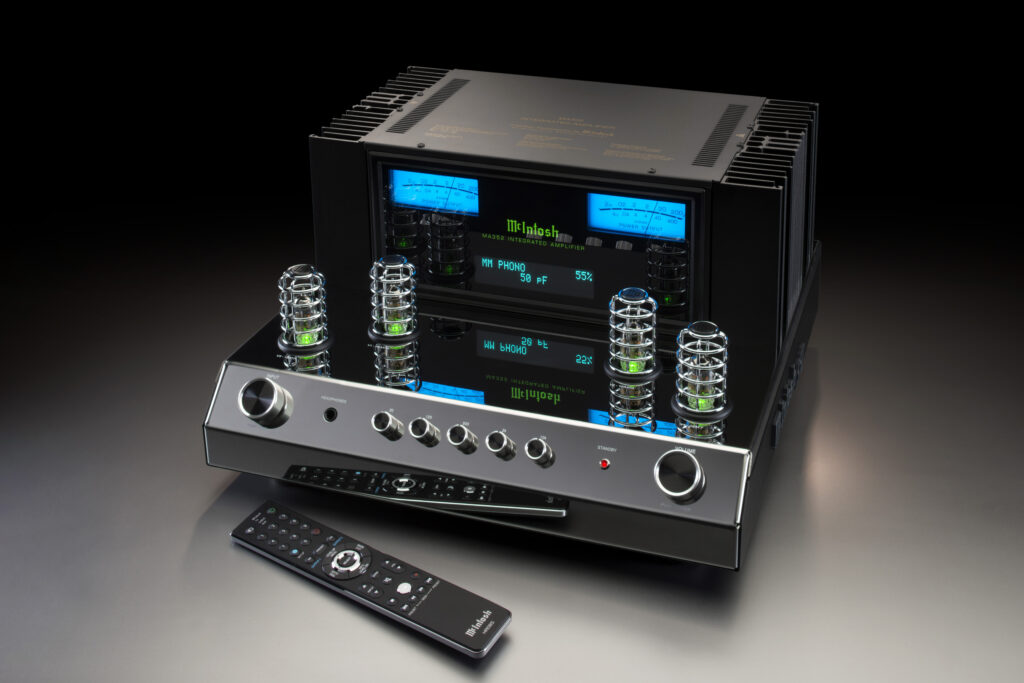
The McIntosh Labs MA352 hybrid integrated amplifier sells for £8,995 ($7,000) and uses a valve preamp and transistor power amp stage. It is an impressively solid piece of kit, weighing in at 30kg, so lift carefully! It has a high-quality chromed stainless-steel chassis. The large, raised section at the rear houses the power amps. You might guess this from the massive heatsinks down the side. This has a glass-fronted display panel that sports two of its signature blue VU power meters and an information display that shows the input selected and the volume setting.
The MA352 has a rotary knob on the far left of the chassis at the front for input selection. There’s a matching one on the far right to switch it on and off and adjust the volume. In between those are the five smaller knobs that control the in-built five-band graphic equaliser. These operate at centre frequencies of 30Hz, 125Hz, 500Hz, 2kHz and 10kHz, with each providing a whopping ±12dB of adjustment. Thankfully, they default to being out of the circuit, and you need to switch them in on purpose using the remote control. I have never felt a need for such things and left them out of the circuit for all my listening. Switch them back on using the remote control for those who wish to play. There is also a headphone jack on the front panel.
Remote power
The remote control alone controls channel balance, mono/stereo, and the capacitive load for the phono stage. Its range of adjustment is between 50pF and 800pF.
The rear panel has four unbalanced RCA line-level inputs, one phono input (MM), and four balanced XLR sockets. Balanced inputs usually offer a worthwhile sonic improvement over unbalanced inputs, which proved the case during my listening tests. There are also preamp and subwoofer output sockets, plus data ports for remote control of other components. One set of gold-plated speaker binding posts is provided.
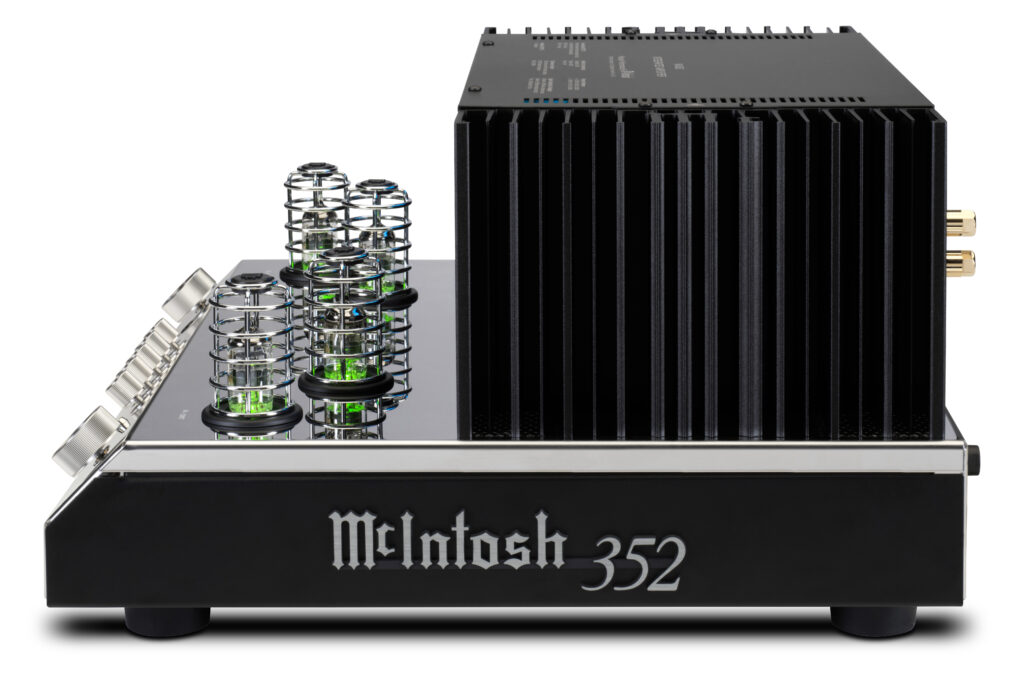
The valves are mounted towards the front of the chassis. To fend off curious little fingers, they have metal guards that slot in around them. The MA352 preamplifier section uses two 12AX7A and two 12AT7 valves. These are illuminated from underneath. An orange glow signifies that they are in warm-up mode. The valves are ready for action when ‘orange’ turns ‘green’. These will also switch back to orange in the unlikely and frankly mind-boggling event that the amp should start clipping.
Substantial
The MA352’s quoted power output is very substantial: 200 watts into eight ohms and 320 watts into four ohms. I never had cause to doubt that it had more than enough driving power for any speaker you could throw at it.
To listen to what the McIntosh Labs MA352 could do, I connected it up to two different systems, one with an Innuos Statement streamer/Meitner MA3 DAC front end through Russell K. 150 speakers and the other using an Audio Note TT3 turntable with Arm Two/Io1 and S9 transformer and Audio Note CDT-Five CD transport and DAC Five Special DAC, both with Russell K. 120Se speakers. I also had to hand a well-respected, similarly priced, high-power transistor-only amp that would prove a valuable benchmark to assess where this McIntosh indeed sits in the market.
Start with a line
Let’s start with line-level inputs and streaming through the Innuos system. I played ‘Smiles And Smiles to Go’ from Larry Carlton’s superb Alone But Never Alone album to kick off. The drums and percussion had a snappy and dynamic quality that impressed me immediately. At the same time, the bass line was tight and easy to follow, driving the track along forcefully. Carlton’s guitar had good leading-edge detail, allowing me to hear how each note was being played better than the pure-transistor amp. The McIntosh was pacey, fast, tight, and tuneful.
Still streaming, I tried the superbly emotive and moody ‘Racing in the Streets’ from Bruce Springsteen’s Darkness on the Edge of Town. The piano on the intro had grace, while Springsteen’s vocals were packed with emotion. The body and presence were tight and explosive, and when the bass line came in, it had weight, power, and movement. I felt that the pure transistor amp did not have the emotion and impact of the McIntosh.
Songbird
Next, I played another emotion-packed song, the sublime ‘Songbird’, performed by Christine McVie on Fleetwood Mac’s Rumours. I remember watching the BBC documentary on the making of this legendary album and Lindsay Buckingham describing how it was just McVie on stage in a church with only the recording crew in attendance. He recalled how there wasn’t a dry eye in the house at the end of it!
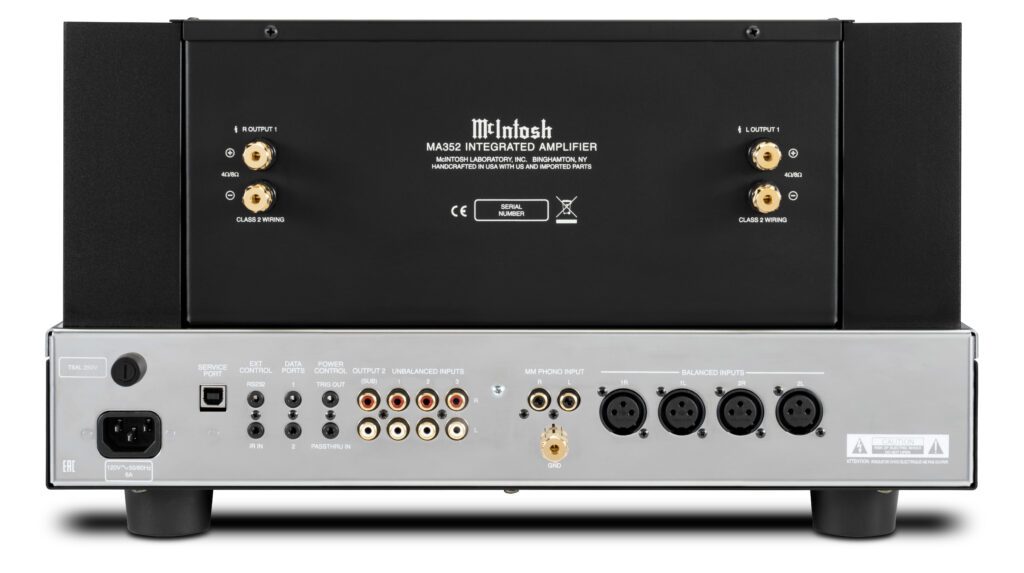
I am pleased to say that the McIntosh Labs MA352 did not let Christine McVie down and conveyed the emotional impact of the performance well. It captured the nuances of her vocals and the piano’s body and gave a good impression of the recording venue.
Switching to the CD source and playing ‘Never Too Far to Fall’ from George Benson’s In Your Eyes album, the McIntosh acquitted itself creditably. It conveyed the track’s layers of vocals and rhythmic impetus well and kept all of the instrumental layers nicely separated.
Groovin’
I then played the title track from one of my favourite Peter White albums, Groovin’, which is White’s cover of the old Johnny Nash classic, ‘I Can See Clearly Now’. On this, McIntosh handled White’s guitar well, capturing its character and the nuances of his play. The reggae-style bass line moved along nicely, with reasonable control and tunefulness. It was also good to hear things like the accordion not getting lost.
‘Sunny Side of the Street’ from Ben Sidran’s Enivré d’Amour was next. I know this track well and can tell you that the McIntosh did not disgrace itself here, with a tight and weighty bass line, great openness and articulation on vocals and a good ‘walk’ to the rhythm. Sidran’s vocals never appeared to shout, and on balance, I enjoyed what the McIntosh Labs MA352 did with the track.
Since a phono input is provided, it would have been remiss of me not to try it. So I used another track from Larry Carlton, his cover of the classic ‘Minute by Minute’ initially released by The Doobie Brothers. Here, McIntosh conveyed the ebb and flow and weight and precision of the bass line well, as well as the skill of Carlton’s guitar play and the nuances of his technique. The MA352 also, I felt, provided an accurate representation of the qualitative differences between the streaming, CD and vinyl sources.
I quickly hooked up some Focal Clear headphones for a brief listen and can report that the MA352 did a very decent job and drove the Focals well. OK, so if you spend several hundred pounds on a separate, dedicated headphone amp, you will doubtless gain an improvement. Still, the McIntosh turned in a perfectly acceptable performance straight out of the box.
Enjoyable
I enjoyed my time with the McIntosh Labs MA352 very much. It turned in a well-balanced, musical, dynamic, and detailed performance. And it did so without any objectionable flaws or defects, letting the side down.
I have listened to a few hybrid integrated amplifiers recently. Undoubtedly, they have generally proved to be an improvement over those comparably-priced entirely transistor competitors I have put them alongside.
The McIntosh retains a valve design’s sweetness, seductiveness, and emotive impact. That’s backed up by a transistor power stage’s heft and driving power. At this price, you’d be crazy not to put it on your shortlist.
McIntosh MA352 Integrated Amplifier REVIEW

This is a review summary written by Terry Ellis August 2023
For the full review please see my YouTube video linked here .
The McIntosh MA352 hybrid integrated amplifier is not a new product, I think it was released back in 2020. I remember seeing the images for it and I struggled with the visual design because it is so unusual, but the idea of a tube pre with big McIntosh power is very alluring, especially with the price tag of £8,995, which is a lot of money, but it’s a lot less than the bigger McIntosh amps such as the MA12000 which costs about double. In that sense the MA352 could be seen as very good value for a big power McIntosh and, being a hybrid, gives it a distinction over other integrated amplifiers.

Design
I’ll start with the visual design because, in the flesh, this is a much better looking integrated than it appears in photographs. From the side, with the flashy McIntosh writing it is a bit quirky although I think quite cool, but some might hate its looks because it is so different. Some will be also likely be indifferent to the LED illuminated tubes but I think they are fine. The tube warm up process is in particular is pretty cool to watch and, of course, you can turn the LEDs off if you want to be boring about it.
Turning the amplifier around there are enough analogue input connections for both single ended and balanced, with inputs for the built in moving magnet phono stage and two subwoofer outputs. However, strange to me are the speaker cable terminals being halfway up the back of the amplifier, which doesn’t really matter, but it does feel a little quirky again
On the front there is a headphone amplifier, which I didn’t test for reasons explained in the video linked here, and there are five bands of tone controls, or equalisation, depending on how you look at it, which could be really great for some audiophiles whereas others will want to disable them which you can.
I have the same gripe about this design as from my review of the formidable McIntosh MA9500 from earlier in the year, the EQ, or tone control, adjustments work well but they have no markings for the user to be precise with their adjustments and when you clean the amplifier, which you definitely will do with the chrome finish, the dials all get moved and you lose all your fine-tuned settings. Something to consider here I think for an amplifier of this value as it could well be your forever amp and having to keep manually resetting them might become a chore if your OCD about keeping your HiFi dust free kicks in, as mine does, often.
In typical McIntosh amplifier fashion this is a large footprint amplifier but at just under 30Kg it is not a heavy amplifier by McIntosh standards and that is probably because it doesn’t have the usual McIntosh autoformers (special transformers designed in-house and manufactured by McIntosh which allow any speaker type to be used with a McIntosh amplifier and have all of the power the amp is designed to deliver). The absence of the autoformers then effects the power, which is 200 watts per channel into 8 ohms and 320 watts per channel into 4 ohms.

How Does It Sound
The MA352 presents which a typical McIntosh sound if your familiar with it. But I think the MA352 is probably my most preferred-sounding McIntosh from the ones I have had in my listening room. Maybe it’s the tube preamplifier or maybe it’s not having autoformers or perhaps it’s just the synergy between the MA352 and the Sonus Faber Serafino speakers I am also reviewing at the moment.
To describe the MA352 sound is pretty easy. It is smooth, or should I say smooooooth! The sound is effortless, even when you crank the volume. It is very grown up and sophisticated, by which I mean instruments or musical elements are positioned perfectly with exceptional composure.
For me, the first key stand-out strength of the MA352 is the sound stage depth and three-dimensionality. Music can feel very deep and beyond the speakers with quite a set-back overall sound. I think this is largely the McIntosh and Sonus Faber pairing at work here. For some audiophiles this type of sound stage will be gold because there is also an impressive extended width to the sound stage.
The second big strength is the bass delivery. The big power available I am sure helps, but it is really solid and controlled and can go deep, making the Serafino sound almost subwoofer like in my small room, not REL 31 subwoofer like, but almost normal subwoofer like. Many amplifiers deliver extended and big bass, but the reason I like the MA352s bass is because it has that nice rounded, bouncy character to it, which adds some pleasing which I found was a more musical bass rather than a very mechanical bass that’s more technical start stop, start stop, like some other amplifiers deliver.
The next big strength might also be a downside for some, and that is the softness and smoothness to the sound. This is quite a romantic sounding amplifier, especially in the vocal region, which has a laid-back ease to it that never becomes aggressive, hard or forward, at least at the volumes levels I could play at which was always under half way, with the VU meters rarely hitting even 20 watts and that was loud.
Interestingly, the treble details are always clear and delivered with the same composure and smoothness. Some audiophiles may find the treble a bit too smooth with some speakers but, I have to say I really liked the character of the treble and the way the musical information was presented. It is stunningly clear with a lot of micro detail but it is more delicate than attacking in its delivery. This overall sound presentation does mean that you can listen to music all day very loud with no listening fatigue, which will be a huge positive for many owners.
The next big strength is the power available. I think you could drive some really big speakers with this amplifier and that makes it very flexible for the future if you’re a greedy audiophile who always wants to upgrade and go bigger.
Thats not forgetting the McInbtosh super-power compared to traditional integrated’s, the ability to change the tubes to tune the sound. This is not something I did for this review, but it is something I would do as an owner, partly because it would be fun to do it and to explore the sonic possibilities but also for modifying the vocal delivery.
Some of you would definitely love the vocals because they are everything I just wrote about above; they are clean, clear, smooth and delicately positioned in an impressive three-dimensional sound stage. The scale of them just keeps getting bigger the more you turn up the volume with their composure never wavering and so with certain speakers this would be ideal. Vocals, as I mentioned before, are delivered a little softer and they have an obvious character which I think is a McIntosh sound characteristic, which means they are also delivered quite neutral or maybe a little vanilla for tone and timbre.
Now neutral, or vanilla is a good flavour that works just as well in deserts as it does in coffee and so what I am saying here is that the MA352s vocal delivery is very versatile across a lot of music. However, vanilla is not as interesting a flavour as maybe strawberry, and definitely not as indulgent as chocolate. For personal preference I would want a bit more going on character-wise with the vocals. Given my recent experience tube rolling, admittedly it was power tubes, but I learnt different tubes really affect the sound, I just wonder if different input and driver tubes couldn’t be used here to add some more special character to the sound of this amplifier for its vocal delivery. I think it probably could, so to me that is a superpower which non hybrid amplifiers don’t offer.
Vinyl
I tested the built in moving magnet phono stage and its sound seemed to mirror a lot of what I liked about the MA352 but in a less definite way. When I compared the MA352 to the AVID Pellar phono stage the AVID clearly had much less of that smooth McIntosh sound. There was more of a focus on clarity overall. In some ways I preferred the McIntosh and in other ways I preferred the AVID but, overall, I found the built in phono stage was more pleasing or just balanced the best of the two with the amplifiers sound. But I didn’t test the vinyl capabilities extensively so please take my findings here with a grain of salt.

Comparisons
My first comparison was with the Galion TS120SE tube amplifier. This was the amplifier that showed to me an extra character to vocals from the Serafino speakers that I wasn’t getting from the MA352. Check out the Galion review and my tube rolling comparisons here to learn more of what I mean by this, but this comparison also showed to me the benefits of the power of the McIntosh for bass delivery and also the size, scale, and composure of the music at louder volumes. In these areas the Galion, while a very good tube amplifier, was still very much outgunned.
Next, I compared the McIntosh to a very powerful solid state integrated amplifier, the Leema Acoustics Tucana II Anniversary, which is a very honest and quite upfront sounding amplifier. With the right speakers it can certainly hold its own with more expensive amplifiers, and it’s only half the price of the MA352. This comparison was really interesting because the Leema sounded more neutral and more direct, its bass was lighter on its feet and punchy, rather than the deep, rounded and sumptuous bass you get from the McIntosh. There was also a lot less character to the music, from the Leema, which is interesting because it showed to me there is definitely some tube character coming from the tube preamplifier stage of the McIntosh which gives music this romantic sense of roundness of delivery with ease and grace. Music from the Leema was more tense sounding, especially in the vocals. I have to say in this instance, with the Serafino speakers, the MA352, despite costing far more than the Leema showed its worth and it felt a much better match for these speakers.

Conclusion
The MA352 is, overall, an excellent amplifier to listen to. It is so smooth and effortless you can listen to music all day. I found myself easily getting lost in the music, no matter what genre was being played. I really liked this McIntosh for electronic music because of the bass and how it romanticises and enriches the varied sounds and samples and how it then pulled me deep into the music in almost trance like fashion which, as far as I’m concerned is what electronic music is supposed to do.
My only real niggle with this amplifier, sonically, is that is maybe plays it a little safe and doesn’t have the bite I might want at times. I was craving a bit more character in the vocal region, but we are talking my personal preferences here, which is potentially unfair criticism.
I think the way this amplifier has been designed to sound it delivers it all with no really obvious weak points. This is a very good value for a big power McIntosh amplifier that takes you a long way towards a bigger McIntosh amplifier sound for a lot less money.


An Essential Audition Award is granted in recognition of a products high performance but with a certain uniqueness that makes auditioning even more essential.
